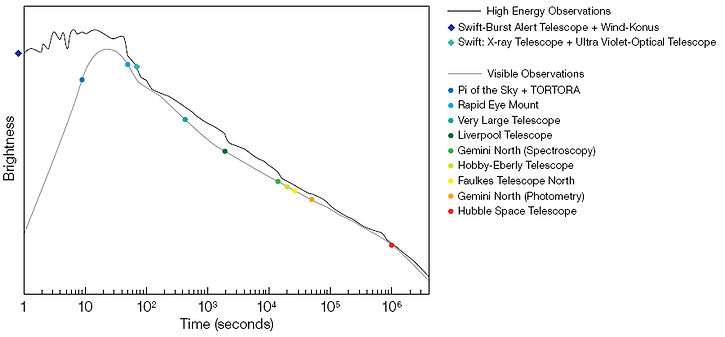GRB 080319B
| GRB 080319B | |
|---|---|
|
The extremely luminous afterglow of GRB 080319B was imaged by Swift's X-ray Telescope (left) and Optical/Ultraviolet Telescope (right). This was the brightest gamma-ray burst afterglow ever observed. | |
| Observation data (Epoch J2000) | |
| Supernova type | Unknown |
| Remnant type | Unknown |
| Constellation | Boötes |
| Right ascension | 14h 31m 40.98s [1] |
| Declination | +36° 18' 8.8 |
| Discovery date |
Swift Burst Alert Telescope (BAT) March 19, 2008 http://grb.fuw.edu.pl |
| Peak magnitude (V) | 5.8 |
| Redshift | z=0.94 |
| Distance |
7.5 billion light-years (2.3 Gpc) z=0.937 |
| Physical characteristics | |
| Progenitor | Unknown |
| Progenitor type | Unknown |
| Colour (B-V) | Unknown |
| Designations | |
| GRB 080319B | |
GRB 080319B was a gamma-ray burst (GRB) detected by the Swift satellite at 06:12 UTC on March 19, 2008. The burst set a new record for the farthest object that was observable with the naked eye:[2] it had a peak visual apparent magnitude of 5.8 and remained visible to human eyes for approximately 30 seconds.[3] The magnitude was brighter than 9.0 for approximately 60 seconds.[4]
Overview

The GRB's redshift was measured to be 0.937,[5] which means that the explosion occurred about 7.5 billion (7.5×109) years ago (the lookback time), and it took the light that long to reach Earth. This is roughly half the time since the Big Bang.[2] The first scientific paper submitted on the event suggested that the GRB could have easily been seen to a redshift of 16 (essentially to the time in the universe when stars were just being formed, well into the age of reionization) from a sub-meter sized telescope equipped with near-infrared filters.[6]
The afterglow of the burst set a new record for the "most intrinsically bright object ever observed by humans in the universe",[2] 2.5 million times brighter than the brightest supernova to date, SN 2005ap.[7]
Evidence suggests that the afterglow was particularly bright due to the gamma jet focusing exactly at the line of sight to Earth. This allowed an unprecedented examination of the jet structure, which appears to have consisted of a narrowly focused cone and a secondary wider one. If this is the norm for GRB jets, it follows that most GRB detections only capture the fainter wide cone, which means that most distant GRBs are too faint to detect with current telescopes. This would imply that GRBs are a far more common phenomenon than so far assumed.[8]
A record for the number of observed bursts with the same satellite on one day, four, was also set. This burst was named with the suffix B since it was the second burst detected that day. In fact, there were 5 GRBs detected in a 24-hour period, including GRB 080320.[9]
Until this gamma-ray burst event, the Triangulum Galaxy, at a distance of about 2.9 million light years, was the most distant object visible to the naked eye. The galaxy remains the most distant permanent object viewable without aid.[2]
It was soon suggested that this spectacle be named the Clarke Event,[10] as it first reached Earth just hours before the death of Arthur C. Clarke, who was the 1956 Hugo Award winner for his 1955 science fiction short story "The Star".
The plot below shows the brightness in both the optical and at higher energy for the event. The first optical exposure started about 2 seconds before the source was first observed by the SWIFT telescope and lasted for 10 seconds. The emission in both curves then peaks at around 60 seconds before a long exponential decay.

See also
References
- ↑ "Gamma Ray Burst Coordinates Network". NASA. March 19, 2008. Retrieved 2008-03-21.
- 1 2 3 4 "NASA Satellite Detects Naked-Eye Explosion Halfway Across Universe". NASA. March 21, 2008. Retrieved 2008-03-21.
- ↑ "Pi of the Sky observation of GRB080319B the brightest ever gamma-ray burst.". Pi of the Sky. March 21, 2008. Retrieved 2008-03-21.
- ↑ "GRB 080319B light curve". vo.astronet.ru. April 1, 2008. Retrieved 2008-04-05.
- ↑ "VLT/UVES redshift of GRB 080319B". March 19, 2008. Retrieved 2008-03-25.
- ↑ J. S. Bloom; Perley; Li; Butler; Miller; Kocevski; Kann; Foley; Chen (March 25, 2008). "Observations of the Naked-Eye GRB 080319B: Implications of Nature's Brightest Explosion". The Astrophysical Journal. 691: 723–737. arXiv:0803.3215
 . Bibcode:2009ApJ...691..723B. doi:10.1088/0004-637X/691/1/723.
. Bibcode:2009ApJ...691..723B. doi:10.1088/0004-637X/691/1/723. - ↑ Schilling, Govert (March 21, 2008). "Universe's most powerful blast visible to the naked eye". New Scientist.
- ↑ Courtland, Rachel (September 10, 2008). "Brightest gamma-ray burst was aimed at Earth". New Scientist.
- ↑ "OLDER Swift Burst Ground-Analysis Information: 2008". GCN. 4 March 2009. Retrieved 2011-04-17.
- ↑ "Why not the Clarke Event?". EarthSky Blogs. March 21, 2008. Archived from the original on 2008-03-28. Retrieved 2011-04-17.
Citations
- Bloom, Joshua S.; et al. (March 25, 2008). "Observations of the Naked-Eye GRB 080319B: Implications of Nature's Brightest Explosion". Astrophysical Journal. 691: 723. arXiv:0803.3215
 . Bibcode:2009ApJ...691..723B. doi:10.1088/0004-637X/691/1/723.
. Bibcode:2009ApJ...691..723B. doi:10.1088/0004-637X/691/1/723. - Racusin, Judith L.; et al. (2008). "Broadband observations of the naked-eye γ-ray burst GRB 080319B". Nature. 455 (7210): 183–188. arXiv:0805.1557
 . Bibcode:2008Natur.455..183R. doi:10.1038/nature07270. PMID 18784718.
. Bibcode:2008Natur.455..183R. doi:10.1038/nature07270. PMID 18784718.
Database references
External links
| Wikimedia Commons has media related to GRB 080319B. |
- Hubble Pinpoints Record-Breaking Explosion
- SkyWatch Show 165: Brightest Explosion Ever Seen -(mp3)
- Simbad
- AAVSO Alert Notice 372 Possible naked-eye gamma-ray burst detected (GRB 080319B)
- ESO Press Release
